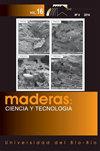木材高分子复合材料粘结贴面基杂化复合材料
IF 1.5
4区 农林科学
Q2 Agricultural and Biological Sciences
引用次数: 0
摘要
木贴面基复合材料由于可以利用短周期生长的小直径人工林木材,目前市场需求量很大。介绍了木质贴面与木质聚合物复合材料的制备及性能表征。本研究探索了木质聚合物复合材料替代甲醛基胶粘剂作为贴面胶粘剂的应用。在聚丙烯基体中嵌入40%竹子颗粒的木质聚合物复合材料以片状形式用于粘结马来酸楝木的贴面。复合材料制备在层压单板木材和胶合板配置。物理力学性能评价表明,木材聚合物复合材料的性能对杂化复合材料的性能有重要影响。所得复合材料的密度明显高于传统胶合板或层压单板木材(690 kg/m3 - 750 kg/m3)。在力学性能方面,胶合板和层压单板木材配置的拉伸和弯曲强度没有统计学差异。复合贴面材配置的弹性模量和抗压强度明显高于胶合板。复合材料的胶剪强度和内粘接强度表明木材聚合物复合材料具有良好的粘接性能,表明该复合材料作为木材单板的粘结剂具有潜在的应用前景。这些复合材料可能是一类特殊的层压复合材料,没有甲醛释放危害。本文章由计算机程序翻译,如有差异,请以英文原文为准。
Wood polymer composite bonded veneer based hybrid composites
Wood veneer based composites have a great demand in present market as the material can utilize small diameter plantation timbers grown at short rotation cycle. This paper presents preparation and characterization of hybrid composites made of wood veneer and wood polymer composite. The study explored utilization of wood polymer composite as an adhesive for bonding veneers replacing formaldehyde-based adhesives. Wood polymer composite containing 40 % bamboo particles embedded in the matrix of polypropylene was used in sheet form to bind the veneers of Melia dubia (Malabar neem) wood. The composites were prepared in both laminated veneer lumber and plywood configurations. The assessment of physical and mechanical properties indicated that the properties of wood polymer composite contribute significantly to the properties of the hybrid composites. The density of the resultant composites was significantly higher (690 kg/m3 - 750 kg/m3) than conventional plywood or laminated veneer lumber. Among mechanical properties, there was no statistical difference in tensile and flexural strength of plywood and laminated veneer lumber configuration. Modulus of elasticity and compressive strength of laminated veneer lumber configuration were significantly higher than plywood. Glue shear strength and internal bond strength of the composites indicated acceptable bonding properties of wood polymer composite which suggests the potential application of these composites as a binding agent for wood veneers. These composites could be a special class of laminated composites with no formaldehyde emission hazards.
求助全文
通过发布文献求助,成功后即可免费获取论文全文。
去求助
来源期刊

Maderas-Ciencia Y Tecnologia
MATERIALS SCIENCE, PAPER & WOOD-
CiteScore
2.80
自引率
13.30%
发文量
33
审稿时长
>12 weeks
期刊介绍:
Maderas-Cienc Tecnol publishes inedits and original research articles in Spanish and English. The contributions for their publication should be unpublished and the journal is reserved all the rights of reproduction of the content of the same ones. All the articles are subjected to evaluation to the Publishing Committee or external consultants. At least two reviewers under double blind system. Previous acceptance of the Publishing Committee, summaries of thesis of Magíster and Doctorate are also published, technical opinions, revision of books and reports of congresses, related with the Science and the Technology of the Wood. The journal have not articles processing and submission charges.
 求助内容:
求助内容: 应助结果提醒方式:
应助结果提醒方式:


